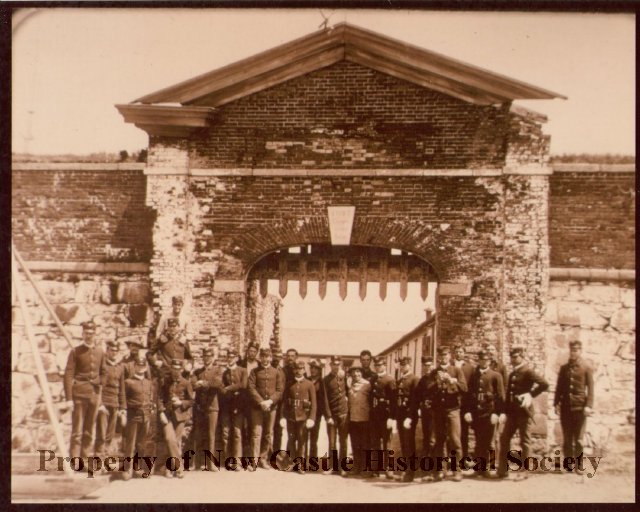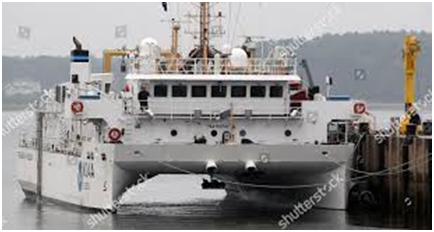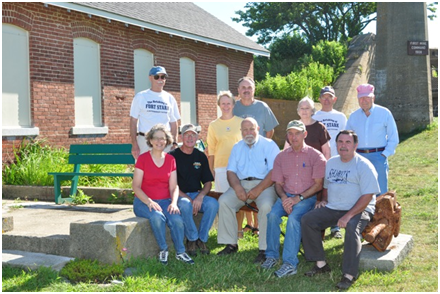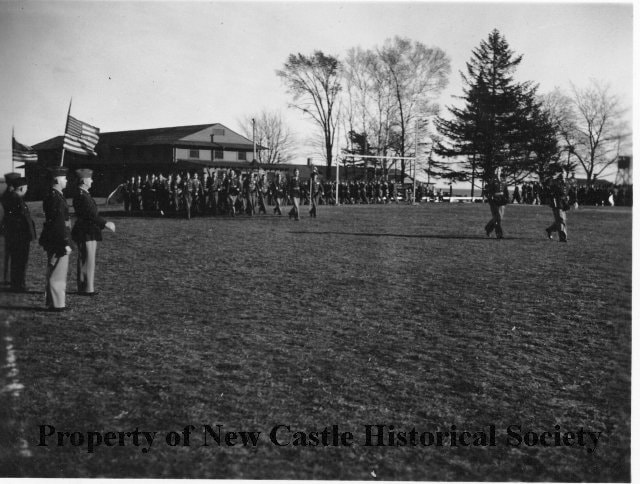New Castle Historical Society
Forts of New Castle Timeline
|
Fort Constitution
Fort Point, located on the northeast corner of Great Island, has always been an active military site guarding the entrance to Portsmouth Harbor. It is the oldest continuously occupied military site in the US
1631- John Mason (who was granted the land for most of New Hampshire) sent a company to erected houses and a fort. It was fortified with ten guns for the defense of the Island and river. entrance. The fort was called "The Castle".
1666 - The fort was rebuilt as a timber blockhouse and renamed “New Castle”. 1693 – The town took the name of New Castle. The fort took the new name of "William & Mary" the British monarchs. At this time a breastwork (sod, logs and debris construction) with 19 guns was constructed to defend the island during the French and Indian War. 1705 - The fort’s first stonewalls were built. During the next 65 years the fort was regularly garrisoned with 4 to 8 men who repaired and enlarged the fort. More guns were added regularly.
1774 - On Dec. 14 & 15, the first overt act of the American Revolutionary War took place at Fort William and Mary. Warned by Paul Revere that the British were coming to take the powder from the fort, 400 rebels mobilized to attack the fort and seize the powder for their own rebel cause. The British ships Scarborough and Canceaux arrived to prevent the dismantling of the fort by the patriots. 1775 - In June of 1775 the Scarborough came into the harbor, dismantled the fort and seized two vessels with provisions. 1806 - Colonel John Walbach took charge of the fort with the largest number of forces yet stationed there. 1809 - During a July 4th celebration, 10 people died when 350 pounds of ammunition caught fire and exploded. 1814 - During the War of 1812, fearing a British invasion, Colonel Walbach mobilized his soldiers and the townspeople to build a Martello tower (circular masonry fort ) which is now called the Walbach Tower. Its purpose was to protect the town beach against British landing parties. 1840 - Improvements were made which included the granite gun platforms, the structure that we still see today.
1861 - At the start of the Civil War, the fort was manned with a 150-man detachment. Construction on granite work continued until 1867.
1897 - Construction began on Battery Farnsworth, located to the north east of the ruins of Walbach Tower. Battery Farnsworth was part of the larger scale Endicott Era Defenses of seacoast fortification of the entire country. At the same time the harbor was planted with 21 underwater mines. 1904- Battery Farnsworth was accompanied by Battery Hackleman with two 3" guns to defend against enemy mine sweepers.
1917 – During World War I, along with many other coastal defenses, two 8" guns from Battery Farnsworth were sent to Europe to be use as railway artillery.
1940 - The Harbor Defenses were garrisoned by the 22nd Coast Artillery Regiment at Fort Langdon to serve Fort Constitution and Fort Stark. 1944 - On March 1st, the 22nd Coast Artillery Regiment was dissolved. Part of the regiment was moved to Camp Hood Texas. 1950 - The Fort was deactivated and turned over to the US Coast Guard. Coast Guard cutters were home ported at the pier. Personnel were quartered in the Light Keeper's House. 1961 - Fort Constitution was designated a New Hampshire Historic Site.
1973 - Fort Constitution was listed on the National Register of Historic Places and open to the public. 2000 - The U. S. Coast Guard turned its pier and other property over to the University of NH for marine science laboratories and classrooms. . The USCG Cutter “Reliance”, which had been using the pier, transferred to the Portsmouth Naval Shipyard. The pier now also serves as the home port for the NOAAS Ferdinand R. Hassler, a vessel that maps the ocean floor. |
Fort Stark
The site of Fort Stark, on the southeast point of New Castle Island known as Jerry's Point, or Jaffrey's Point, has been fortified in one form or another since earliest times. Historian John Albee writes, on this point were probably the oldest defenses along the coast.
1630s - Thomas Walford, one of New Castle’s earliest settlers, arrived with his wife and family and established a farm and orchard on the land that is now called Fort Stark.
1649 – Thomas Walford granted the land to his son, Jeremiah, hence the name Jerry’s Point. 1697 – Soldiers were ordered to build a breastwork to prevent the landing of an enemy as they passed Little Harbor. 1745 - The fort was first heavily fortified with six brass guns, provided by merchants of London to protect against pirates. 1746 - Theodore Atkinson, Colonel of the New Hampshire Militia, fortified the point with nine 16, 24 and 32 pounders from Fort William and Mary to defend against the French. 1774 - In the Dec. 1774 raids, the guns at Jerry's Point were removed.
1775 - When the British war ship The Scarborough, arrived the locals removed the cannons to keep the British from taking them. Later that year, additional guns were put in place from Fort William and Mary, courtesy of the December 1774 Raid on Fort William and Mary. 1873 - The federal government purchased Jerry's Point and started construction on a concrete and earthwork 12-gun battery known as "Battery Stark". 1887 - Jerry's Point Lifesaving Station was built along with a wooden pier that remained in service until 1908. It was then replaced by the new Portsmouth Harbor Lifesaving Station on Wood Island Kittery Maine.
1898 - The Army Corps of Engineers constructed the large stone breakwater (that still remains) and pier on the southern tip of the point. Following the Spanish-American War, two 8-inch breach-loading rifles were emplaced on the parapet that was built in 1874. 1900 - The fort was officially named "Fort Stark" to honor William Stark, commander of the New Hampshire Militia during the American Revolution. 1904 - Batteries David Hunter and Edward Kirk were completed. 1907 – The fort was part of the Harbor Defense along with Fort Foster and Fort Constitution. Facilities for controlling the underwater mine fields in the harbor were added. Batteries Hayes and Lytle defended the mine field.
1917 - During World War I, the guns of Battery Kirk were removed and sent to Watertown Arsenal for conversion into railway artillery to be used by the American Army heading to France. 1920 - Here atop Batteries Hays and Lytle was located the Primary Fire Command observation station, later to be designated the Harbor Defense Command and Gun Group (G1) observation station. The fort was then placed on care-taker status. U.S. Army, soldiers from the 8th Coast Artillery regiment took up residence in the Old Lifesaving Station. 1940 - The fort was reactivated and many new buildings were constructed. A mess hall, fire station, officers' quarters, Quartermaster Supply building, gate house, and other supply and office buildings were constructed. Some personnel were billeted at Camp Langdon. The old Lifesaving Station was converted into the Navy signal tower where signalmen alerted the Coast Guard picket boat to open or close the gate in the anti-submarine net which stretched across the harbor from Fort Stark to Fort Foster. 1942 - The combined Harbor Entrance Control and Harbor Defense Command was built on top of Battery Kirk. This served as the communication and command center to control the entire Portsmouth Harbor Defense Area, which extended from Cape Porpoise, Maine to Cape Ann, Massachusetts. It was built to resemble the superstructure of a navy ship, and was painted in camouflage during the war. The top of the structure housed surveillance radar within a radar dome. 1948 - All remaining Harbor Defense Commands were deactivated. The U.S. Navy then acquired the fort, and stationed about 30 Ships-Keepers and a civilian technician for harbor defense operations.
1963 – Two Navy 3-inch guns were placed on the new Battery Lytle’s gun blocks as a memorial to the USS Thresher, submarine #593, lost while operating from the Portsmouth Naval Shipyard. One gun has since been returned to the shipyard and one gun is now in the museum at Fort Stark. 1979 - The federal government turned over to the State of New Hampshire 10 acres to be used as a park. All remaining buildings were then destroyed, except for the Ordnance Machine Shop and the batteries themselves. 2007 - “Friends of Fort Stark,” a local preservation group, was founded to clear and restore the neglected area for park use.
|
Camp Langdon
Known today as the Great Island Common. The U.S. Army began acquiring the land in 1909 through several deeds, eventually totaling 32.3 acres. The purpose of the reservation was to house the soldiers from the 22nd Coastal Artillery. It also contained anti-aircraft guns and a searchlight.
1882 – The wealthy Portsmouth merchant, Jacob Wendell, II, purchased a portion of this land over a period of five years and built the grand summer mansion “Frostfields”.
1910 – The United States Government acquired the land and used the mansion for officers quarters. It eventually tore down Frostfields. It called this land the "New Reservation".
1916 - During World War I, Anti-Aircraft Battery No. 1 was located here. It consisted of two 3-inch anti-aircraft guns, model 1917, on concrete gun blocks. 1930s - The guns were removed in the early 1930's. During the inter-war years, the Portsmouth defenses were put on caretaker status.
1937 - The reservation was renamed "New Castle Military Reservation". 1940 - The 22nd Coast Artillery Regiment (Harbor Defense), U.S. Army, was organized. 1941 - During World War II the post became the Headquarters and main garrison area for the four local forts. The reservation was renamed Camp Langdon, after the former state Governor and Senator John Langdon. An armory, barracks, hospital, training buildings, storehouses, warehouses, and a concrete jetty and pier were constructed.
1943 - Several units of the regiment were declared obsolete and deactivated. The surplus personnel were then mostly reassigned to combat units then shipping out overseas to Europe and the Pacific. The units remaining were then redesignated as the Harbor Defenses of Portsmouth.
1946 - The remainder of the regiment was officially disbanded. 1948 - The U.S. Army transferred 27 acres of Camp Langdon to the U.S. Navy. The Navy then referred to the post as "Camp Langdon Annex", or "Camp Langdon Naval Reservation", which was placed under the U.S. Naval Disciplinary Command, (the Portsmouth Navy Prison) Naval Base, Portsmouth. 1954 - The camp reopened as a part of the Navy Retraining Command, a program to restore soldiers to duty. Several new buildings were constructed, and most of the older buildings were demolished or rebuilt.
1961 - The southwestern portion of 2.8 acres, was transferred to the U.S. Marine Corps for administration and training of the 54th Rifle Company, USMC Reserve. 1963 - The remainder of the Naval Annex was transferred to the Town of New Castle for park and recreation usage, now known as "Great Island Common".
The Great Island Common is comprised of 32 acres of seaside greenspace and beach, and is open to the public 365 days a year. |
To donate to the New Castle Historical Society please use the Donate Today Button below. Thank You
|
© 2024 - New Castle, NH Historical Society Design by safollansbee@gmail.com























